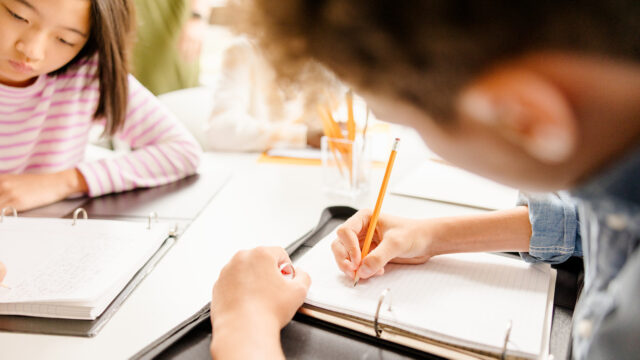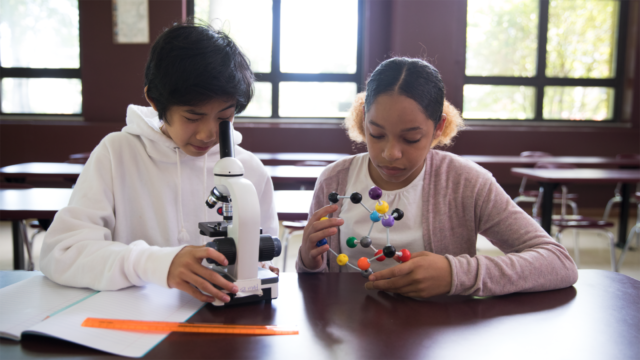
Are you ready to help your class achieve its full potential? Let’s look at examples of creative classroom activities for students to bring passion and excitement to your curriculum.
Examples of creative classroom activities
1. Make learning a hands-on activity
It’s one thing to read about a scientific experiment, but it’s an entirely different experience to actually conduct one yourself. A teacher can describe how to set up an electrical circuit, but students will learn more by getting hands-on with a battery and wires. Interaction is a key to effective learning and children who take an active role with hands-on activities retain more information and have a greater understanding of the subject.
How can you achieve this in your own classroom? Here are some creative classroom ideas:
- When reading a play in English class, divide your students into small groups to act out the sections.
- When teaching about the cell cycle, have your students identify the stages that cells are in by observing skin or plant cells under a microscope.
- When learning about 3D shapes, allow students to create their own replicas using straws and other available materials instead of looking at diagrams or pictures.
2. Consider your classroom flow
Today’s classroom should be flexible to meet the needs of a variety of activities. There’s a time for facing the front and listening to the teacher, but there should also be room for group work, whole-class presentations, independent work assessments, and paired discussions.
The key to good classroom flow lies in the layout. A group workspace is always a good addition to your class, with a large area of empty floor space that can be used for a range of purposes. Experiment with several options to find what works best for your learning environment.
3. Facilitate debates and discussions
Effective self-expression is a key element of any creative classroom. Students should have the freedom to speak their minds and express their opinions. To do this, there must be an open approach to discussion within the learning space. As the teacher, you’re tasked with facilitating meaningful conversations, challenging conventional viewpoints, and teaching students the difference between facts and opinions. Through thoughtful evaluation and interactive debate around a given topic, students can learn about critical thinking and engage with their learning materials.
4. Bring color to your classroom
Color has a place in every classroom. It’s common in elementary education, but even older students can benefit from the use of color in unconventional and creative ways within their learning environment. By integrating color as an educational tool, you can help students to absorb information more rapidly. Color-coded notes, mood corners, and inspirational posters can all benefit a child’s ability to learn and think more creatively.
5. Offer choice as a standard
Rather than requiring each student to write an essay to demonstrate their understanding of a topic, why not ask your students to pick a format that they like while still meeting your required criteria? Some may choose to assemble a presentation, while others may prefer to create a poster or even a dramatic performance. Plenty of students enjoy writing and will want to write that essay.
By offering students a choice, you foster an environment in which they can prove their knowledge through the method that suits them best. That way, you can assess whether a student’s performance reflects their academic abilities in an area that they shine. Choice boards are a great tool that gives students a menu of options to choose from.
6. Make goal setting part of everyday learning
Teachers set goals for their students, but are your students setting any for themselves? Part of a creative curriculum involves encouraging students to think about what they want to achieve. Once they know where they’re headed, they can take the right steps to get there. Without knowing the final destination, how can your students take actionable steps to get there?
The personal learning goals will naturally vary for different students. While one student may want to improve their spelling, another may be determined to use more creative vocabulary or work toward expressing themselves more clearly in writing. To set a suitable goal, students must objectively assess their own strengths and areas for improvement. They must determine what they need to achieve and then plan how they can reach their goal.
Of course, an essential part of goal setting is retrospection. Students should consider whether they achieved the goal they set for themselves. If not, they should note what went wrong and how the obstacles can be overcome in the future.
7. Make team building a priority
In all aspects of life, working as a team is essential to success, but it’s also how we can channel our creativity most effectively. Cooperation allows ideas to be shared, new solutions to be devised, and innovative decisions to be made. Working together also facilitates effective conversations and discussions, allowing for creative collaboration to take place.
Team building exercises should be part of the everyday classroom environment. Playing cooperative games and participating in group challenges both have a key role in building positive interactions. This type of interactivity also provides an effective sounding board for students to share their ideas and derive inspiration from their peers.
8. Mix up student groups
If given the chance, some students will always choose the same partners and groups when teamwork is required. This results in limited creativity, and being too comfortable with any setup eventually causes stagnation. But selecting unusual groupings can unleash a surprising amount of creativity. When students are paired with less familiar classmates, they broaden their horizons and learn how to work with others.
You should also encourage students to take on new roles when they switch groups. For instance, if one student was the notetaker in their last group, they could be the presenter in the next. As a result, they may discover new skills and unlock fresh potential. By simply shuffling groups around from time to time, you can help your students to learn more about themselves and what they can bring to the table.
9. Challenge students with open-ended questions
A closed question demands a set response. For example, asking what the character's name is or where the story takes place may give students the opportunity to demonstrate their understanding of what they have read, but it doesn’t look beyond the surface to the deeper concepts that the author intended. Open-ended questions encourage students to put themselves in the author’s position, to use their empathy, and to use their wider knowledge of the book and its context to generate a creative and thoughtful response to your questions. For example, an open-ended question could be to discuss important themes of the story or alternative ways the character could've solved the conflict.
Open-ended questions help students start to open their minds to the possibility that there is more than one answer to any problem. Once students adapt to this idea, they can begin to use their natural inquisitiveness and creativity to determine a range of potential solutions.
The importance of creative thinking in the classroom
Your classroom is the focus of your students’ learning journey. Try these creative thinking activities for students to nurture their imagination and problem-solving skills. By fostering creative thinking in a classroom that is open to discussion and student contribution and by introducing collaborative and thought-provoking activities into the curriculum, you can allow creativity to flow through the whole school day.
This article was adapted from a blog post initially developed by the education technology company Classcraft, which was acquired by HMH in 2023. The views expressed in this article are those of the author and do not necessarily represent those of HMH.
***
Find more lesson plans and classroom resources on Shaped.
Be the first to read the latest from Shaped.
Be the first to read the latest from Shaped.














